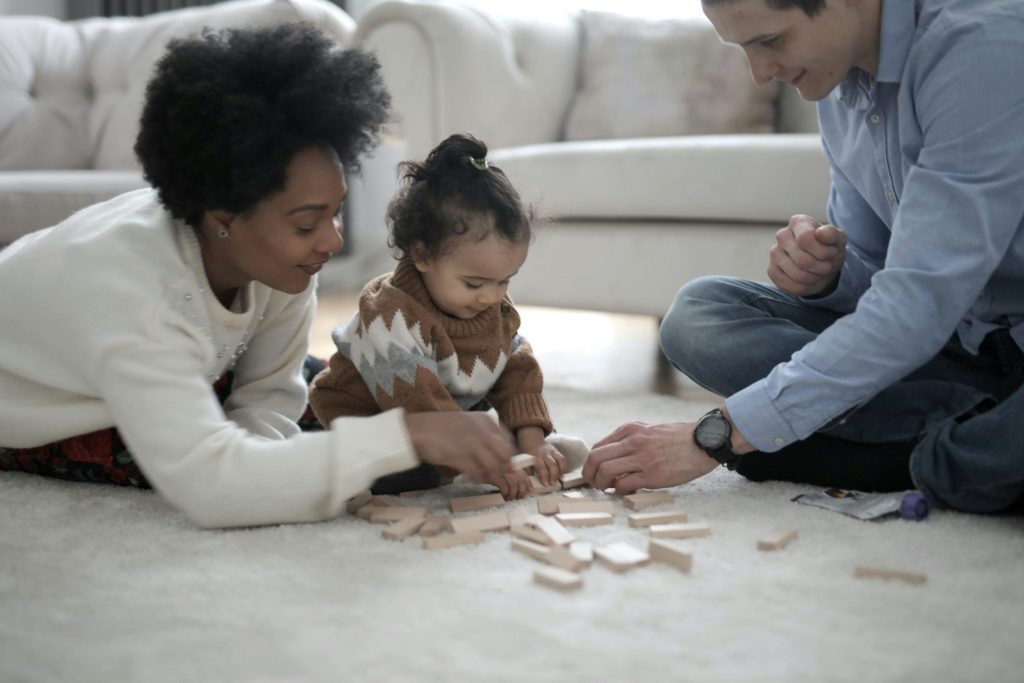
Have you ever felt overwhelmed by the countless parenting approaches out there? 🤔 In a world where advice seems to come from every direction, gentle parenting stands out as a beacon of hope for many new parents. This compassionate approach focuses on creating a loving, nurturing environment that fosters your baby’s emotional and physical well-being.
But what exactly is gentle parenting, and how can you implement it in your daily life? 🤱 Whether you’re a first-time parent or looking to refine your parenting style, understanding the principles of gentle parenting can transform your relationship with your little one. From creating a soothing physical space to developing effective communication strategies, this approach covers all aspects of your baby’s development.
In this blog post, we’ll explore the seven key elements of gentle parenting that can help you build a strong, loving bond with your baby. We’ll delve into understanding the philosophy behind this approach, discuss how to create a nurturing environment, and share practical tips for fostering emotional connections. Get ready to discover how gentle parenting can not only benefit your baby but also bring more joy and fulfillment to your parenting journey. 💖

Understanding Gentle Parenting
A. Definition and core principles
Gentle parenting is a compassionate approach to raising children that emphasizes empathy, respect, and understanding. At its core, this parenting style focuses on fostering a strong emotional connection between parent and child while promoting the child’s autonomy and self-regulation.
The core principles of gentle parenting include:
- Empathy: Understanding and validating your child’s emotions
- Respect: Treating your child as an individual with their own thoughts and feelings
- Boundaries: Setting clear, age-appropriate limits with kindness
- Positive reinforcement: Encouraging good behavior through praise and rewards
- Communication: Using effective, non-violent communication strategies
| Traditional Parenting | Gentle Parenting |
| Punishment-based | Guidance-based |
| Parent-centered | Child-centered |
| Authoritarian | Authoritative |
| Reactive | Proactive |
| Focus on obedience | Focus on understanding |
B. Benefits for child development
Gentle parenting offers numerous benefits for a child’s overall development:
- Emotional intelligence: Children learn to recognize and manage their emotions effectively
- Self-esteem: Positive reinforcement builds confidence and self-worth
- Problem-solving skills: Encourages critical thinking and decision-making
- Empathy: Children learn to understand and consider others’ feelings
- Stronger parent-child bond: Creates a foundation of trust and open communication
C. Debunking common misconceptions
Despite its growing popularity, gentle parenting is often misunderstood. Let’s address some common misconceptions:
- Myth: Gentle parenting means no discipline
Reality: It involves setting clear boundaries with empathy and respect
- Myth: Children become spoiled or entitled
Reality: Children learn self-regulation and respect for others
- Myth: It’s too time-consuming and impractical
Reality: While it requires patience, the long-term benefits outweigh the initial challenges
- Myth: Gentle parenting is permissive
Reality: It balances nurture with structure and guidance
By understanding these core principles, benefits, and addressing misconceptions, parents can make informed decisions about implementing gentle parenting techniques in their own families. This approach sets the foundation for a loving and respectful relationship with your child, promoting their overall well-being and development.

Creating a Nurturing Physical Environment
Setting up a safe and comfortable nursery
Creating a nurturing physical environment for your baby starts with setting up a safe and comfortable nursery. Here are some key considerations:
- Choose soothing colors: Opt for soft, calming hues like pastels or neutrals
- Ensure proper lighting: Install dimmer switches for adjustable lighting
- Invest in a quality crib: Select a sturdy crib that meets safety standards
- Use breathable bedding: Choose natural, hypoallergenic materials
Choosing appropriate toys and materials
Selecting the right toys and materials is crucial for your baby’s development and safety:
| Age Range | Recommended Toys |
| 0-3 months | Soft rattles, high-contrast mobiles, unbreakable mirrors |
| 3-6 months | Teething toys, soft blocks, musical toys |
| 6-12 months | Stacking cups, board books, shape sorters |
Implementing baby-friendly home modifications
To create a safe environment beyond the nursery:
- Install safety gates at staircases and doorways
- Cover electrical outlets with childproof covers
- Secure furniture to walls to prevent tipping
- Remove or secure loose cords from blinds and curtains
By focusing on these aspects, you’ll create a nurturing physical environment that supports your baby’s growth and development while ensuring their safety. Remember to regularly reassess and adjust your home as your baby grows and becomes more mobile. With a secure and stimulating environment, you’ll provide the foundation for your child to explore and learn confidently.

Fostering Emotional Connection
Practicing responsive caregiving
Responsive caregiving forms the foundation of a strong emotional connection with your baby. This approach involves:
- Promptly attending to your baby’s needs
- Interpreting and responding to their cues accurately
- Providing consistent and nurturing care
By practicing responsive caregiving, you create a sense of security and trust in your child, fostering a deep emotional bond.
Using positive reinforcement techniques
Positive reinforcement is a powerful tool in gentle parenting. It involves:
- Praising desired behaviors
- Offering encouragement and support
- Using rewards effectively
| Technique | Example | Benefit |
| Verbal praise | “Great job sharing your toy!” | Boosts self-esteem |
| Physical affection | Hugs or high-fives | Strengthens emotional bond |
| Small rewards | Extra playtime or a special treat | Motivates positive behavior |
Developing empathy and understanding
Cultivating empathy helps you connect with your baby on a deeper level. To develop empathy:
- Put yourself in your baby’s shoes
- Acknowledge their feelings without judgment
- Validate their emotions, even if you don’t agree with their actions
This approach helps your child feel understood and valued, strengthening your emotional connection.
Encouraging secure attachment
Secure attachment is crucial for your baby’s emotional development. To promote it:
- Be consistently available and responsive
- Provide comfort during times of distress
- Engage in quality one-on-one time
These practices create a strong foundation for your child’s future relationships and emotional well-being.

Effective Communication Strategies
Using a calm and respectful tone
When communicating with your baby, maintaining a calm and respectful tone is crucial. This approach not only helps in building trust but also sets a positive example for future interactions. Here are some key strategies:
- Speak softly and evenly, even when frustrated
- Use positive affirmations and encouragement
- Avoid harsh or threatening language
- Practice patience and take deep breaths when needed
Employing active listening skills
Active listening is essential, even with infants who can’t yet speak. It helps in understanding their needs and fostering a strong bond. Consider these techniques:
- Pay full attention to your baby’s cues and sounds
- Respond promptly to their attempts at communication
- Maintain eye contact during interactions
- Reflect back their emotions through facial expressions
Utilizing age-appropriate language
Adapting your language to your baby’s developmental stage is crucial for effective communication. Here’s a guide:
| Age | Language Approach |
| 0-3 months | Use simple words, repetition, and sing-song tones |
| 3-6 months | Introduce more varied vocabulary and short phrases |
| 6-12 months | Use simple sentences and name objects frequently |
Incorporating non-verbal cues
Non-verbal communication plays a significant role in interacting with babies. Enhance your communication by:
- Using expressive facial expressions
- Employing gentle touch and hugs
- Demonstrating actions while speaking
- Utilizing gestures to reinforce verbal messages
By implementing these strategies, you’ll create a rich communication environment that supports your baby’s development and strengthens your bond. As we move forward, we’ll explore how to establish healthy boundaries while maintaining this nurturing approach.

Establishing Healthy Boundaries
Setting consistent routines
Establishing consistent routines is crucial for creating a sense of security and predictability for your baby. A well-structured daily schedule helps children understand what to expect, reducing anxiety and promoting better behavior. Here are some key elements to consider when setting up routines:
- Morning routine
- Mealtime schedule
- Nap and bedtime rituals
- Playtime and learning activities
| Time | Activity |
| 7:00 AM | Wake up and morning cuddles |
| 8:00 AM | Breakfast and getting dressed |
| 9:30 AM | Playtime or outdoor activities |
| 12:00 PM | Lunch and story time |
| 1:00 PM | Nap time |
| 3:00 PM | Snack and gentle learning activities |
| 6:00 PM | Dinner and family time |
| 7:30 PM | Bath and bedtime routine |
Implementing gentle discipline techniques
Gentle discipline focuses on teaching and guiding rather than punishing. It helps children understand the consequences of their actions and develop self-control. Some effective gentle discipline techniques include:
- Positive reinforcement
- Redirection
- Natural consequences
- Time-ins (instead of time-outs)
- Problem-solving together
Teaching self-regulation skills
Self-regulation is the ability to manage emotions, behavior, and body movements in different situations. By teaching these skills early, you empower your child to handle challenging situations independently. Some strategies to promote self-regulation include:
- Modeling emotional control
- Encouraging deep breathing exercises
- Using “feeling words” to express emotions
- Creating a calm-down corner with soothing activities
- Practicing mindfulness through age-appropriate activities
By implementing these strategies, you create a supportive environment that fosters your child’s emotional growth and helps them develop essential life skills. Remember, consistency is key when establishing boundaries, and patience is crucial as your child learns to navigate their emotions and behaviors.

Promoting Positive Self-Image
Offering genuine praise and encouragement
Genuine praise and encouragement play a crucial role in fostering a positive self-image in children. When offering praise, focus on specific actions and efforts rather than general traits. For example, instead of saying “You’re so smart,” try “I’m impressed by how hard you worked on solving that puzzle.”
Here are some effective ways to offer genuine praise:
- Be specific and descriptive
- Praise effort and progress, not just outcomes
- Use a warm and sincere tone
- Avoid comparisons with other children
Supporting autonomy and independence
Encouraging autonomy allows children to develop confidence and a sense of capability. Provide age-appropriate opportunities for your child to make choices and solve problems independently.
| Age | Autonomy-supporting Activities |
| 6-12 months | Offer simple choices (e.g., between two toys) |
| 1-2 years | Allow self-feeding, simple dressing tasks |
| 2-3 years | Encourage helping with household chores |
| 3-5 years | Involve in decision-making (e.g., choosing outfits) |
Cultivating a growth mindset
A growth mindset helps children understand that abilities can be developed through effort and perseverance. Encourage your child to embrace challenges and view mistakes as learning opportunities.
Celebrating individual strengths and abilities
Recognize and nurture your child’s unique talents and interests. This helps build self-esteem and a positive self-image. Create opportunities for your child to showcase their strengths and provide support in areas where they may struggle.
By implementing these strategies, you’ll help your child develop a strong, positive self-image that will serve them well throughout life. Remember, consistency and patience are key in this ongoing process of nurturing your child’s self-perception.

Nurturing Physical and Mental Well-being
Prioritizing proper nutrition and sleep habits
Proper nutrition and adequate sleep are crucial for a baby’s physical and mental well-being. Here’s a breakdown of essential nutrients and recommended sleep durations:
| Age | Daily Sleep Needs | Key Nutrients |
| 0-3 months | 14-17 hours | Iron, DHA, Vitamin D |
| 4-11 months | 12-15 hours | Iron, Zinc, Vitamin A |
| 1-2 years | 11-14 hours | Calcium, Vitamin C, Protein |
To ensure your baby gets proper nutrition:
- Breastfeed exclusively for the first 6 months if possible
- Introduce solid foods gradually after 6 months
- Offer a variety of nutrient-dense foods
- Avoid added sugars and excessive salt
For better sleep habits:
- Establish a consistent bedtime routine
- Create a calm sleep environment
- Respond promptly to nighttime needs
Encouraging regular physical activity
Physical activity is vital for your baby’s development. Here are some age-appropriate activities:
- Tummy time for newborns
- Reaching and grasping exercises for 3-6 month olds
- Crawling games for 6-12 month olds
- Walking and climbing activities for toddlers
Promoting sensory exploration and play
Sensory play helps babies understand their world and develop crucial skills. Try these activities:
- Texture boards with various materials
- Water play with different temperatures
- Musical instruments for auditory stimulation
- Scented playdough for olfactory exploration
Supporting cognitive development through stimulating activities
Engage your baby’s mind with these cognitive-boosting activities:
- Reading books together daily
- Playing simple memory games
- Introducing basic problem-solving toys
- Encouraging imaginative play as they grow older
By focusing on these aspects, you’ll create a nurturing environment that supports your baby’s overall well-being and development. Next, we’ll explore how to implement these strategies in your daily routine.
Conclusion

Gentle parenting is a powerful approach that creates a loving, supportive environment for your baby to thrive. By focusing on nurturing physical spaces, fostering emotional connections, and using effective communication strategies, parents can build strong foundations for their child’s development. Establishing healthy boundaries, promoting a positive self-image, and prioritizing both physical and mental well-being are essential components of this parenting philosophy.
As you embark on your gentle parenting journey, remember that consistency and patience are key. Embrace the learning process alongside your child, and don’t be afraid to adjust your approach as needed. By implementing these gentle parenting principles, you’re not only creating a harmonious home environment but also setting the stage for your baby’s lifelong emotional intelligence and resilience.





